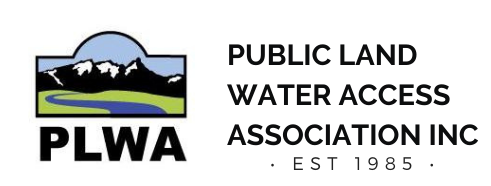Old Indian Trail / Cowboy Heaven Summary
OLD INDIAN TRAIL OPENED
The opening of Old Indian Trail was one of the earliest projects of the Public Land Access Association in 1988. Closed by a New York businessman, it lead to the “ Cowboy Heaven” east of Ennis lake. PLAAI (now PLWA) initiated legislation and won the judgment. Following the court order, Montana Power and BLM financed construction of a handicapped fishing access site and a trail head which exist to this day.
“The skirmish that put Public Land Access on the map involved the Windy Water Ranch. Tucked away in a corner of southwest Montana near Yellowstone National Park, Windy Water is a 2,390-acre tract of rolling alpine meadow surrounded by the Rockies, dotted with sage and matted with stands of conifers. It borders on a national forest, including a pristine, splendidly isolated elk ground called Cowboys Heaven.
The ranch was bought in 1986 by millionaire Robert M. Lee, owner of Hunting World, an exclusive sporting goods store in New York City. Hoping to provide a ‘protected habitat’ for game animals, Lee later decided to close a portion of what locals knew as the Old Indian Trail where it passed through his land. ‘Hunting pressure’ from outfitters ‘has been so heavy in recent years,’ he explained in a letter to the Forest Service in 1987, that mature bull elk were seldom seen in the area.
Even though the original route of the Bannack Indians had been changed by a previous owner, the Old Indian Trail was the route many hunters took to reach two prime elk regions, including Cowboys Heaven.
At 63, Hawkes is a feisty Idaho native whom opponents regard as a hothead. He organized Public Land Access to give voice not only to hunters and fishermen but also to “motorcyclists, 4-by-4s, snowmobilers, backcountry horsemen, all of ’em.” Once he heard about the planned closing of the Old Indian Trail, he wrote Lee and warned that if Public Land Access didn’t hear from him within 10 days, the group would sue.
According to Hawkes, Lee ‘didn’t try to negotiate. He just put up ‘No Trespassing’ signs. It was the arrogance of a big out-of-state landowner who came and said the hell with local people that got him in trouble.’
Public Land Access sued Lee on the grounds that the trail was a prescriptive right of way–that is, a historically used route–and thus public. In a landmark decision in 1988, the first in which a state court declared a trail public by prescription, a Madison County District Court judge ruled in favor of Public Land Access.”
